Satellite Pins Texas Earthquakes on Oil and Gas Wastewater


Last week Stanford University researchers added yet another straw to the pile of evidence connecting oil and gas activities to damaging earthquakes. Their new study, published in the journal Science, draws attention to the fact that oil and gas fracking is just one contributor to a more widespread problem.
Fracking and earthquakes
The recent boom in oil and gas fracking has introduced negative impacts into local communities -- spurring residents, environmental organizations, health experts and policymakers to call for tighter regulations.
In some states -- New York and Maryland, for example -- the case against natural gas fracking was strong enough to result in statewide bans. Scores of local communities also initiated fracking bans within their limits, though their authority to do so is often challenged.
However, the focus on fracking in general and natural gas fracking in particular muddies the waters when it comes to earthquakes.
Fracking is short for hydraulic fracturing, an oil and gas drilling method that involves shooting a chemical brine into shale formations. So far, fracking was linked directly to earthquakes only in rare instances.
The much more pervasive problem is the practice of disposing oil and gas wastewater into wells, often at high pressure.
Natural gas fracking contributes tremendous new quantities of wastewater to the disposal stream, but it is not the only source. Some of that wastewater can come from conventional oil and gas drilling operations, and some of it comes from fracked oil wells.
A case in point is Oklahoma. The state is suddenly a global earthquake hotspot due to wastewater disposal, and state officials have finally begun to treat the situation as an emergency.
The bulk of the wastewater, though, is contaminated saltwater from conventional drilling. Fracking wastewater only accounts for about 10 percent of the total statewide.
Texas earthquakes linked to oil and gas wastewater
The practice of disposing wastewater into wells is relatively cheap compared to other options such as treatment and reclamation. The domestic oil and gas industry relies on well disposal to keep costs down, so the new Stanford study could have an impact on conventional drilling as well as fracking operations.
Researchers used a satellite-based sensor called InSAR (short for Interferometric Synthetic Aperture Radar) to chart minuscule changes in the Earth's surface related to a 4.8-magnitude earthquake that occurred near Timpson, Texas, in 2012.
As described by Stanford, four disposal wells began operating near Timpson between 2005 and 2007. The high-volume wells accounted for about 200 millions gallons of wastewater annually.
The researchers matched up disposal records from those wells with the information from InSAR and spotted a pattern linked to the 2012 earthquake.
In addition, the researchers were able to determine a difference based on the depth of the well. The four wells received roughly equal volumes of wastewater, but two of them were relatively shallow. The shallow wells produced a much lesser degree of seismic activity because an insulating layer of rock kept the wastewater from going deeper and migrating into a formation called a crystalline basement.
That's significant because crystalline basements are the faulted rock layers where earthquakes originate.
The deeper wells were a different story:
"... The combination of stiffer rock and the impermeable “blocking formation” above allowed the rising pore pressure to migrate downward and build up until it triggered earthquakes in 2012 along an ancient fault line. The quakes ended in late 2013, when pressures began to decline after wastewater injections were scaled back considerably."
Whither wastewater?
A better understanding of site-specific geological conditions is needed before disposal wells go into operation, the Stanford researchers concluded. But increasing restrictions on disposal wells could cause huge problems for the oil and gas industry.
Oil and gas wastewater consists mainly of brackish water that occurs naturally underground. It comes to the surface as "produced water" during oil and gas operations, so the thinking is that it can simply be replaced back into the ground in another location.
It's more than water, though. Lead researcher William Ellsworth of the Stanford School of Earth, Energy and Environmental Sciences explains:
“You can think of the wastewater as ancient ocean water. It’s too salty and too contaminated with other chemicals to treat economically, so the only viable solution at present is to put it back underground.”
In a recent AP article about the Oklahoma situation, Chad Warmington of the Oklahoma Oil and Gas Association echoed that sentiment:
"These are multimillion-dollar wells in some cases that you can't operate any more, period. If you take away your disposal activity, there's nothing else you can do with that water."
Stay tuned.
Image (screenshot): Shake map near Timpson, Texas courtesy of USGS.
Global Aviation: Innovation and the Modern Silk Road


Seldom does the average airline passenger consider the fine points of aircraft design or jet propulsion technology while attending the ritual of boarding an airplane. Unless you’re an aviation nerd, the typical traveler rarely gives jet engines and airframes a second thought, let alone consideration of the global impacts commercial aviation. It’s all just there.
To the untrained or disinterested eye, there isn’t much difference between a 757, a 737 or an A320. Maybe that’s the point. Long gone is the sense that jet travel is “cool” or novel. Once an adventure, air travel today is a mundane, yet essential, fact of life.
Modern commercial aviation is a social utility, the “real World Wide Web." Like other utilities, the industry faces increasing consumer demand, regulatory requirements, shifting economics, climate change and sustainable resource management.
A First World problem?
Flying may be commonplace for some. But in a world where it’s estimated that 80 percent of people have never flown on an airplane, or where 663 million people lack access to clean water, concerns about the future of aviation may seem an issue for the developed world to sort out.
In fact, aviation is an essential component for sustainable development as emerging economies grow a burgeoning global middle class.
This is particularly true as humanity becomes a predominantly urban species. In 1950, when the nascent airline industry plied the skies with propeller-driven aircraft, the global urban population numbered 776 million people, most of whom never dreamed of flying in an airplane. Goods and people moved mostly by ship, truck and rail.
In 2014, more than 3.9 billion people lived in cities. By 2050 the urban population is expected to reach 6.4 billion people. If 80 percent of the world’s population has never flown on an airplane, this urban diaspora portends the massive growth expected in aviation. As people in emerging economies pour into cities and join the global middle class, they will gain access to the connectivity and opportunity of the urban environment.
Sustained innovation: Collaboration vs. disruption
Like the oft-used term “paradigm shift," “disruption” is an expression overused to the point of either being misunderstood or losing much of its significance.
Clayton M. Christensen, scholar, author and management consultant, says: "Disruption is, at its core, a really powerful idea. Everyone hijacks the idea to do whatever they want now. It's the same way people hijacked the word 'paradigm' to justify lame things they're trying to sell to mankind."
An entire book can be written about the real meaning of disruptive innovation (in fact, many have). Christensen developed his theory of disruptive innovation more than 20 years ago. Considered by some as the darling of Silicon Valley, arguably the home of "disruptive innovation," Christensen's ideas draw criticism -- particularly in the notion that once a technology matures, it becomes "good enough." This, Christensen asserts, leads to standardization and modularization -- dissipating the competitive advantage of early leaders. In 2006, Christensen forecast the imminent demise of the iPod, as well as the failure of the iPhone, arguing that what is true for Apple is evident as well in aircraft.
A full discussion of Christensen's theories is well beyond our sustainable business scope here at 3p. I argue, however, that where he falls short is in his assessment of the aviation industry and its significance in global development, trade and culture. The aviation industry has a history of disruption, but it is collaboration and connectivity that continue to drive innovation. It is a model that stretches back decades.
Take, for example, the Boeing 707: In October 1958, the Boeing 707 jet airliner entered commercial service. The “disruptor” of its time, the airplane made its inaugural flight as the Pan American Airlines Jet Clipper America, flying from New York to Paris. The venerable airplane wasn’t the first passenger jet on the scene, but its impact is felt to this day. More than any other single machine, the 707 transformed civilian aviation.
Technically, the 707 made high-speed, high-capacity, long-distance jet travel economically feasible. Culturally, the sleek jet ushered in a new era of “cool” in the public consciousness, complete with Frank Sinatra’s “Come Fly With Me” riding the radio waves. With the 707 came the shrinking world to which we are now accustomed.
The jet age was born.
The engine makes the jet, innovation makes the engine
No jet age happens without a jet engine. The four twin-spool, axial flow Pratt & Whitney JT3 engines powering Pan Am’s first Paris-bound 707 were revolutionary for their time. The engines were a product of years of research, testing and collaboration.
Soon after, the airplane was retrofitted with the JT3D, Pratt & Whitney's first production turbofan engine. As the name suggests, a turbofan engine incorporates a fan at the front of the engine. This fan allows much of the airflow to "bypass" the engine core, significantly increasing thrust without any additional fuel burn. The bypassed airflow also decreased engine noise over the turbojet design.
The basic turbofan jet engine design is now the industry standard for commercial aviation. The concept of the jet engine is many decades old, but through sustained innovative effort, it continues to improve. A turbofan engine produced today is typically 15 percent more fuel efficient than a decade ago, delivering 40 percent lower emissions.
But there is little time to rest.
After 20 years of development, at a cost of $10 billion, Pratt & Whitney has introduced the PW1000G family of jet engines, taking the turbofan to the next level. Airbus delivered PW1000G-powered A320s to carriers in Europe and Asia earlier this year. The geared turbofan design reduces fuel burn over current turbofan engines by 16 percent, regulated emissions by 50 percent and overall noise footprint by 75 percent.
The geared turbofan engine is a huge leap forward in meeting the goals of the FAA's Continuous Lower Energy, Emissions and Noise program. All three components work together. In 1970, the "noise contour" at Chicago's O'Hare airport -- the area affected by departing and arriving aircraft -- was 89.3 square miles. By 2020, thanks to innovations like the PW1000G, the noise contour is projected to decrease to 17.6 square miles.
The jet age goes global, meeting the challenge of a new century
In April of 2010, Iceland’s Eyjafjallajökull volcano spewed volcanic ash high into the atmosphere, closing off large parts of European airspace for eight days. For a month, various sectors were closed due to ash. An estimated 100,000 flights were canceled, and 10 million passengers were delayed.
Just-in-time supply chains were disrupted across two continents. Producers of seafood and flowers in Africa had to lay off workers. Tourism collapsed. Economic losses rose into the billions. If there was any doubt, this single event made clear how fundamental aviation is to the global economy and to people's lives, whether they've ever flown in an airplane or not. It is the "modern silk road."
Air travel connects people, creates economic opportunity and support sustainable urban development. But it isn't all pie-in-the-sky. Significant challenges remain if we are to meet the development and climate goals outlined by United Nations -- and aviation will play a huge role in a low-carbon future.
The aviation industry continues its legacy of sustained, collaborative innovation in a troubled, changing world. There is great opportunity in adversity. The key to success is the same everywhere: perseverance, collaboration and innovation.
Image credits: Storm Crypt (via Flickr)
Data visualization: Wolfram Alpha
Infographics: UTC
White House: Climate Change is a National Security Issue
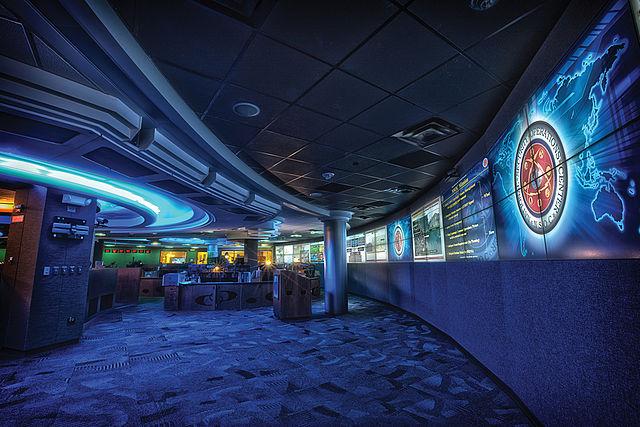

A new Presidential Memorandum calls on more than 20 federal agencies to take the national security implications of climate change into consideration. This is a step in the right direction as evidence of the link between climate stress and conflict grows.
Climate change is the biggest challenge of our generation, and its impacts go far further than just the environment. Businesses, cities and sectors such as travel all are taking climate change into consideration as they plan for the future.
But until recently, America's military was, for the most part, still seeing the world through the old lens of nation-states and geopolitics, despite evidence that climate change was impacting conflict as well.
“It is well-established that climate change is a threat-multiplier that catalyzes conflict and creates instability. Climate change is a underlying driver of natural disasters and extreme weather events, increases human migration, and contributes to conflicts around resources, such as food and water,” Andrew Light, distinguished senior fellow at the World Resources Institute, said in a press statement. “Without action, these threats will surely increase.”
Strong evidence backs Light's claim that climate change can have an impact on security. In fact, both Syria and Venezuela – two countries going through incredible violence right now – faced massive climate pressure that created social instability. Addressing climate change impacts could at least help mitigate the potential for conflict.
Moreover, there is another major concern: climate refugees. Small populations are already being forced to evacuate increasingly uninhabitable islands in the Pacific, and what is a trickle now could become a verifiable rush. Hundreds of millions of people, if not billions, live along low-lying coastlines in countries highly vulnerable to rising sea levels. The world is not at all equipped to deal with massive population shifts – the ongoing political crisis over refugees' resettlement in Europe attests to that – and climate change could only make this worse.
This just the first step, as our military-industrial complex is still oriented to fighting and responding to acts of war, not preventing conflict that could take place because of climate change. Nevertheless, this is a welcome shift and could be one of the most enduring pieces of President Barack Obama's legacy.
“The United States is for the first time integrating climate science with its intelligence and policy priorities,” Light said. "[This] directive is a major step toward preparing the U.S., to respond to climate change, a grave threat to the nation's security and people around the world.”
Preventing the worst of climate change will require all of us – businesses, nonprofits, the media and, yes, even the military and intelligence agencies – to come together and face this immense challenge. This latest action is another sign that we are finally overcoming years of right-wing (and corporate) climate denial and beginning to face up to this immense challenge.
Photo Credit: National Security Agency via Wikimedia Commons
Greenpeace: Bayer and Syngenta Knew About Pesticide Harm to Bees, Did Nothing
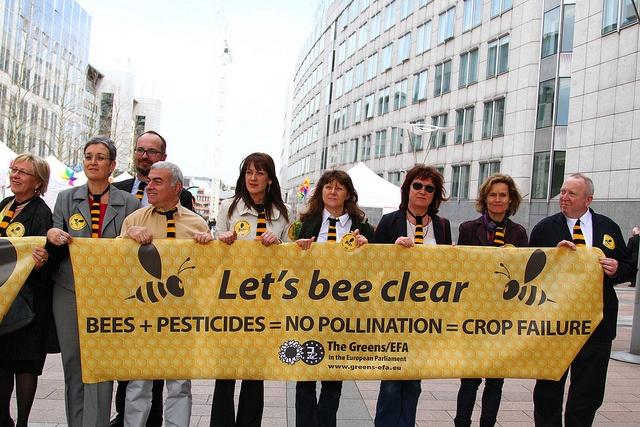

According to internal research documents obtained by Greenpeace under the Freedom of Information Act, both Bayer and Syngenta knew well about the negative impacts of neonicotinoid insecticides. Yet they still chose to sell the products widely, and even actively argued against independent studies connecting them to bee population declines.
The decline of bees has become a global issue, raising real concerns about the future of agriculture. For years, scientists struggled to figure out the cause – until they were able to connect it to a class of insecticides widely used around the world.
“Over recent years there has been a growing body of evidence that seed-coated neonicotinoids are harmful to beneficial insects, including bees. However, most of these studies are based on short-term experiments on honeybees,” said Dr. Nick Isaac from the Center for Ecology and Hydrology in Oxfordshire, in a press statement.
Enter environmental activists, who for years raised alarms about the growing power of big agricultural companies, and their impacts on the environment. We owe Greenpeace a big thanks for using the power of the legal system to access these two companies' internal research and sharing it with the public.
In fact, what the NGO found should reverberate throughout the entire agricultural industry. It shows, clearly, that these companies don't consider the planet's health enough when making business decisions.
"If Bayer and Syngenta cared about the future of our pollinators, they would have made the findings public," Greenpeace's Ben Stewart told the Guardian. "Instead, they kept quiet about them for months and carried on downplaying nearly every study that questioned the safety of their products. It's time for these companies to come clean about what they really know."
Had both companies been more open about their research, we could have connected bee declines to their products far earlier, and perhaps prevented the catastrophe from becoming so widespread. By grandstanding, these companies only made the problem worse, while continuing to profit at the expense of the environment.
If this sounds familiar, it's probably because it is. Earlier this year, Inside Climate News broke a major story that ExxonMobil, the world's largest publicly-traded oil company, knew about climate change years ago and not only hid that knowledge from the public, but also actively funded climate-denier research.
Exxon is now being investigated by the SEC and numerous state attorneys general for fraud. Syngenta and Bayer deserve the same treatment, given this evidence, and must be held responsible for the massive environmental damage their products have knowingly caused around the world.
This should also serve as a wake-up for greater transparency in the agriculture and biotech industries. Scientific research that has such wide-ranging impacts on our environment cannot be done behind closed doors at mega-corporations that are concerned about profit, not planet.
This information needs to be in the public domain, ideally under the purview of institutions such as universities so scientists everywhere can analyze impacts and ensure we don't release chemicals into the environment with such horrific, wide-ranging, negative impacts.
We know that #ExxonKnew. Now we also know that #BayerKnew and #SyngentaKnew.
Image credit: GreensEFA via Flickr
Mobile Health Can Bring Eye Care to Developing Countries
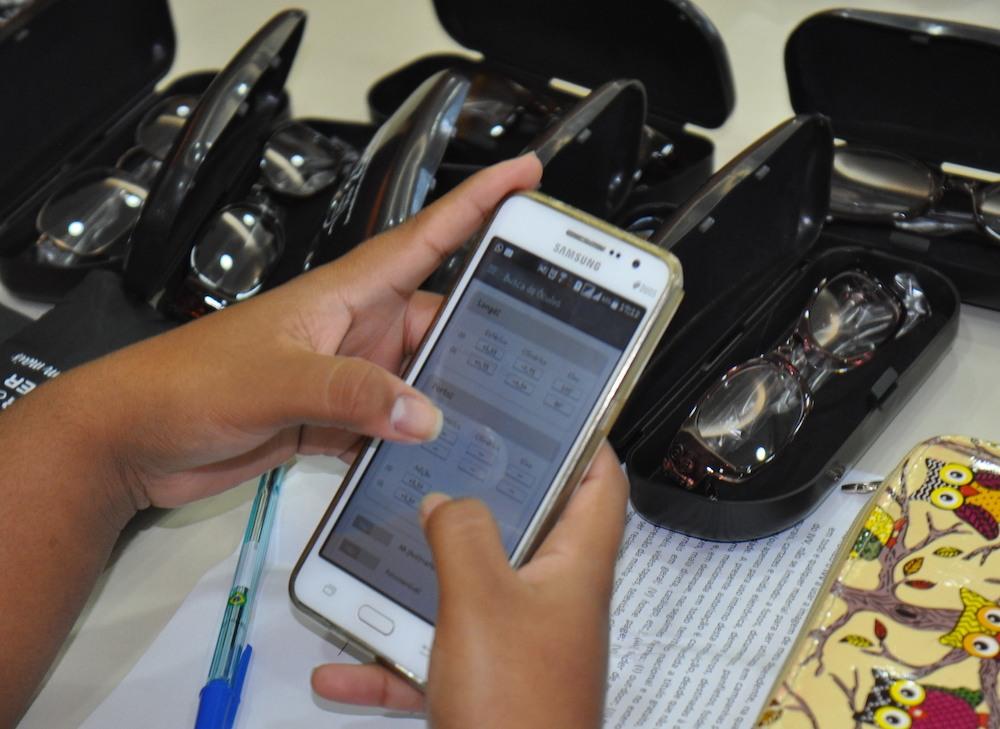

By Jayanth Bhuvaraghan
Two years ago, the number of mobile devices in the world officially overtook the number of people. And this milestone couldn’t have been hit without the exponential growth in emerging markets. Over a billion mobile phones are used in India, for example – more than three times the number owned by Americans. And while a mobile phone in the developed world is a convenience, in the developing world it can be a lifeline, particularly in rural areas.
Where previously huge swathes of the population was socially excluded, mobile devices now have the potential to provide information on the latest commodity prices or weather forecasts, and put access to commerce, banking and even healthcare within reach of even the most remote communities.
From rural India to the favelas of Rio, recent advances in mobile health are helping to provide access to health care for communities that were previously completely cut off from established clinics. Vision care is no exception: with 2.5 billion living with the social and economic consequences of uncorrected poor vision, the potential to change lives through a simple touch of a phone screen is an unprecedented opportunity that NGOs and private sector corporations alike are seizing with both hands.
Connecting communities for better vision
Mobile technology is already being used around the world to facilitate the last mile delivery of products and services. This is the case with Instituto Ver e Viver’s Vision Ambassador program in Brazil, which works in the poor communities of Rio to train individuals to step up and work as primary providers of vision care. Using a digital app on their phones to read prescriptions, the Vision Ambassadors are able to propose and sell low-cost eyeglasses on-site to friends and neighbors who would otherwise never have been able to afford to correct their sight.
The Vision Ambassadors are also leveraging their phones to raise awareness of the vision screenings camps they organise. They use their own social media profiles, or, for guaranteed success, call upon local ‘digital marketers’ in their communities who for a very small sum will help advertise their work via extensive WhatsApp networks. The majority of Ambassadors are women, and the extra income they earn helps increase their financial independence while improving the health and prosperity of other residents in their community.
Making life easier for primary service providers in India
While using mobile technology to bridge the gap between patient and provider is an obvious solution to healthcare challenges, it can also make life easier for primary providers by simplifying financial management. Essilor’s Eye Mitra Optician (EMO) inclusive business initiative recruits and trains under-employed youth to bring affordable eye care to rural and semi-urban communities in India.
Although the initiative is only three years old, 1,800 EMOs have already been trained and have today served upwards of 400,000 customers in their communities. To help them to manage their finances, a mobile phone-based money transfer service is being piloted with 141 EMOs in Karnataka.
As well as increasing the transparency of payments, the service is also making the process quicker and easier, freeing up the EMOs to spend more time conducting vision screening in their communities. Next in line for digitization will be the ordering process itself, simplifying the task of stock selection to the click of a button.
A Peek into mobile disruption
Even if 70,000 individuals were screened each day, it would still take a century to reach each of the 2.5 billion people affected by uncorrected poor vision. This is before taking into account the number of technicians who would need to be trained to conduct the tests, or the cost of the equipment involved.
That’s where mobile applications like Peek Acuity come into play. Peek is a mobile application that can be paired with a lens adapter to convert an ordinary smart phone into a vision screening device. It is accurate, as proved by randomized trials in rural Kenya, and, importantly, it is fast. In 2015, 25 teachers across 50 schools used the device to screen 20,000 in just two weeks. This is the sort of disruptive technology that, if brought to scale, would unlock the potential to improve the sight of millions of people around the world.
Calling all innovators
While mobile health technology is already being used to improve how vision care is brought to low-income consumers in underserved communities, the examples above are just the start. An easy-to-use and affordable technology that could administer a reliable eye check would change lives at a revolutionary scale and speed.
A few promising examples of this are being tested today, but they are often either too costly or too complex in terms of the training required to ensure that an accurate reading is obtained. In other cases, namely in remote or rural villages, the vision measurement process may not be easily understood by children and the elderly, leading to potential inaccurate diagnosis and the many consequences that can incur.
Essilor has launched the See Change Challenge to uncover low-cost and scalable solutions that can be used by primary vision care providers to measure refractive errors in underserved areas. While mobile health is a rich vein to be tapped by potential entrants, the Challenge is not limited to would-be app-developers. Essilor is appealing to innovators across all disciplines to lend their expertise to develop any solution that can meet the criteria outlined on the See Change Challenge website. Winning solutions will receive financial awards – 25,000 euros in cash for up to five winners of the first phase and an additional 100,000 euros for up to two final winners – as well as the chance to see their solution scaled to make a lasting and tangible impact in underprivileged communities around the world.
Image courtesy of Essilor
Jayanth Bhuvaraghan is Chief Mission Officer for Essilor International.
Essilor is the world leader in ophthalmic optics with a presence in 100 countries. The Group designs, manufactures and markets an extensive range of vision care solutions that help to correct, protect and prevent risks to the visual health of around one billion people worldwide.
The See Change Challenge is open for applications until October 21, 2016. Read more about the Challenge and how to apply here.
You can learn more about Essilor’s work to eradicate poor vision at www.essilorseechange.com and by following @SeeChange4all.
Zara Launches Sustainable Fashion Line for Fall


Society’s craving for fast fashion has an adverse impact on people and the planet, but the world’s largest apparel companies say they are working to solve the problem. One such firm is Inditex, which owns the popular chain Zara. The Spanish retailer launched a new fashion line, Join Life, for autumn. It says the collection “embraces a woman who looks into a more sustainable future.”
Zara describes the androgynous, mineral- and earth-toned collection of denim, masculine-cut coats and frilled blouses as reflecting the company’s social and environmental commitment. Zara claims a holistic approach to its commitment to environmental and social sustainability.
First, the company says the 6,000 factories spread across its 1,700 suppliers all comprise a sustainable supply chain. During 2015, those factories were subjected to at least 10,900 audits. While the country has a global supplier base, as any major fashion chain would, Zara says 60 percent of the factories with which it works are either based in Europe or within relatively closer markets such as Morocco and Turkey.
Then there is the environmental street cred of the clothes themselves. More sustainable raw materials such as organic cotton, Better Cotton and recycled fibers are a start. For its synthetic fabrics, Zara uses Tencel, a fiber derived from wood and bamboo that the company, along with other fashion companies, say is a more sustainable option than viscose or rayon. And without quite defining what “animal friendly” means, the company says it is sourcing more recycled wool, ceased using angora wool two years ago and does not use leather or other materials from animals exclusively killed for their skins.
As for the boxes in which clothes are shipped or gifted, Zara describes them as “boxes with a past,” with the result that the company presents data suggesting that it has both reduced the number of trees felled and the amount of carbon emitted into the atmosphere. And when it comes to timber and wood, Zara claims anything in its stores from tags to office stationery have some level of sustainability certification.
Finally, don’t forget the site on which you are perusing Zara’s clothes. At least 84 percent of the energy needed to power the company’s web site is supposedly sourced from clean energy. By 2018, Zara has promised that all of its servers and offices will run 100 percent on renewables.
There is no shortage of fashion designers and writers who insist that fast fashion is unsustainable and is enacting irreparable harm to the planet – and as we saw in Bangladesh three years go, the thirst for cheap clothing has resulted in the cheapening of lives and even killing people. So while much work undoubtedly lies ahead, it appears the world’s largest retailers, including Zara’s competitors, are listening to these concerns and are changing how they do business.
For example, H&M claims it is improving the recycling of its unwanted clothes and has strived to stamp out abuse within its supply chain. The pan-European retailer C&A has told TriplePundit that it is working on scaling up more sustainable sources of cotton. Even UK-based Primark, which the sustainable fashion writer Lucy Siegle excoriated for its profit-driven business model at all costs, has jumped on the sustainable fashion bandwagon.
As is the case with many global industries, the garment sector needs to prove it can somehow do more with less. Zara’s promotion of its sustainability chops often comes across as smarmy, but the improved transparency and more conscientious business practices are steps in the right direction.
Image credit: Zara
Apple Sows Seeds of Change in the Smart Home Market
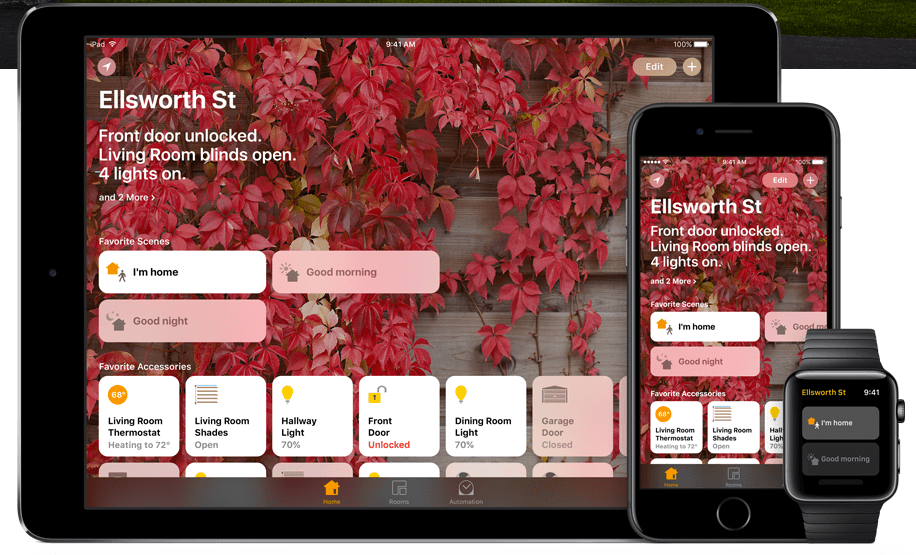

By Emma Bailey
The arrival of iOS 10 officially introduced Apple’s hotly-anticipated HomeKit platform app, with an aim to uncomplicate home automation once and for all. With the new Home app “baked in," iOS 10 confirms this platform is -- by company standards -- finally ready for primetime, after over two years of patient waiting and promises from Cupertino.
For developers and manufacturers, the Home app may seem to be a revelation. In the words of Apple, it is a "robust framework" and a "common protocol" that finally allows all HomeKit-enabled products to work seamlessly with iOS running on an iPhone or iPad. Now built into the iOS Control Center, there is support for new types of devices, including home security cameras, doorbells and air conditioning units. HomeKit-compatible products can now also be controlled through iOS 10's new interactive notifications.
Apple's arrival in home automation
When Apple debuted its HomeKit architecture in 2014, it seemed as though the tech behemoth was finally going to “lay down the law”and drive the adoption of uniform standards for mass consumption. However, a few key problems with Apple's approach remained: The user still had to control each product via individual, third-party apps, and at launch, only a few manufacturers supported HomeKit. At that time, Apple, far from achieving any unity or simplicity in the smart-home space, merely added its presence to the already crowded market.Apple has long been at the helm of the world’s technological progress. It was the first generation iPod that truly drove digital media players towards ubiquity. And indeed, Apple has also managed to corner the global smartphone market with it’s simple, stylish interface for uncomplicated -- not to mention irresistible -- usability. The company remains the world's largest seller of smartphone devices.
The home automation market, however, has proven to be a much different story. There are many barriers preventing mass-market smart home tech adoption, but the “technological fragmentation of the smarthome ecosystem” remains the largest obstacle between the early-adopter phase and the mass-market phase, in which manufacturers are capable of proving a need for their devices.
Cracking the competition
Thermostats that automatically regulate temperatures, door locks that you can operate remotely, and similar wonders of an “automatic” home offer endless opportunities for convenience. But the wow factor lessens considerably when you have to learn a new interface and control scheme for each and every device. Fluid, harmonious functionality is dependent upon multiple pieces of hardware working in tandem to make life easier. This can't happen if every device operates in isolation and can't interface with its peers.With the release of the Home app, Apple comes closer to remedying many of these issues. If a smart appliance says, "Works With Apple HomeKit," users should be able to connect it to the new app, and easily check it while at home or away. From the platform users simply set up “scenes” that consist of different configurations of the home environment, and can switch between them easily. To better compete with Amazon, and Google's similar device called "Google Home," Apple has also opened up Siri to outside developers, enabling voice recognition and control of smart home products that work with the Apple Home ecosystem.
Connecting to consumers
Cupertino is thus gathering strength to become more than just a comprehensive resource for consumers who have stuck it through as smart home early-adopters. By installing the Home app on everyone’s phone - all iPhone users who upgrade to iOS 10 will have no choice in the matter -- Apple undoubtedly sees the potential of a larger victory, turning the tide towards achieving ultimate victory in the ruthlessly competitive connected home market. For the millions of loyal Apple users internationally, the presence and convenience of smart home machinery may begin to seem quite tempting, if not totally necessary.Critics within the industry have speculated that the company purposefully delayed the introduction of the Home app for a couple of years to give developers time to make their offerings compatible with HomeKit, before launching a completely consumer-centric interface.Still, the platform has its limitations, leaving room for persistent, reasonable doubts. Siri has a lot of catching up to do (lagging behind Amazon's Alexa and other voice-enabled products), and the HomeKit platform's list of possible smart product integrations is shorter than what we see from competitors (such as Nest, Samsung's SmartThings and Wink).
With many other tech builders so firmly planted in the interconnected home-object arena, the function and meaning of Apple's Home system relies upon a profoundly loyal and committed consumer base. The company's heritage is its biggest advantage - by allowing the hugely successfully iPhone and iPad to work as comprehensive remote controls, the Home app could finally be the stepping stone needed to encourage a broad shift in the public's attitude towards smart home services and applications.
Image courtesy of Apple
Emma Bailey is a freelance writer and blogger from the Midwest. After going to college in Florida she relocated to Chicago, where she now lives with a roommate and two rabbits. She covers current topics in technology and issues pertaining to the environment.
High performing business: the what & why of purpose


Why is Corporate America So Silent on Race?


In July 2015, a little more than a year after 18-year-old Michael Brown was shot and killed by police in a St. Louis suburb, a New York radio station produced a four-minute video clip of 12-year-olds talking about race issues. The point was to examine how the racial unrest in Ferguson, Missouri, and other cities affected youngsters in school and at home. Were the kids aware of racial tensions in their neighborhoods? How did it impact them? How did it affect their relationships with other students at school? And what did those conflicts say to them about their society and their perceived role?
The results were eye-opening for educators. Kids were deeply affected by racial unrest, irrespective of whether it happened in their city or hundreds of miles away. One 12-year-old African American boy summed up what the shootings in Ferguson and other cities meant to him:
“I feel a little scared if I just walk down the street," said the 12-year-old student. "You know, cops might just think I'm doing something bad. And then if I try to explain to them [I’m not] they won't listen, and they'll just start beating me up and doing terrible things to me.”
Racial conflict has always been an uncomfortable topic for Americans to discuss. But hearing a child’s fear of being subjected to violence just because of his skin color compelled many of us to act. In the months following the video, numerous educators and parents spoke out, calling on schools to talk about the impact of the shootings and protests with their students. Experts offered insights on ways parents could incentivize more school action. Parents created websites to offer tips on ways to help kids verbalize anxiety. Some schools got behind the call for action.
Interestingly what wasn’t discussed by educators, social workers and sociologists at the time was how racial tensions affected the child’s family members at home. The conversation didn’t extend to how the parents who watched the same disturbing images on TV each night were internalizing the news when they went off to work each day. It didn’t discuss whether those same supportive discussions that now take place in some schools should also be encouraged in workplaces.
An open atmosphere of sharing was being encouraged in public schools to help kids deal with what they may have watched on TV or heard from their friends. But in many workplaces across the country, the topic of race relations and the impact racial violence may have on workers was, and still is, an overlooked topic of discussion.
Yet the fact remains that employees are just as affected by incidents of racial violence as their kids, especially when the violence involves members of their own race or community, said Jennifer Brown, a diversity and inclusion expert and author of the new release, "Inclusion: Diversity, the New Workplace and the Will to Change."
"It is foolish to think that employees aren't walking into work worried about issues that are impacting their community of identity or origin, whether locally or on the national stage,” Brown told TriplePundit.“News of police shootings or hate-inspired events like the Pulse Nightclub massacre in Orlando weigh heavily not only on employees whose communities are most directly affected, but on the hearts and minds of colleagues of all identities who stand in solidarity as allies.”
How an employer responds to the emotional impact of that news can have a profound effect on the employee’s comfort level at work. It can also be a deciding factor in that employee's relationship with the employer.
Although the proverbial 'show must go on' mantra persists at work, "an employer’s or leadership team’s silence (or a co-worker’s silence) can be interpreted as a denial of something happening loudly in the culture at large, and [can be interpreted by the employee] as a lack of caring and acknowledgement of those very employees affected the most. The silence is, as they say, deafening; trust can be broken in that moment.”
Often employers are afraid to open sensitive issues, Brown continued, concerned that “once they speak up it will snowball” into a situation they aren’t able to control rather than creating opportunities for productive engagement with their employees. She said employers that make this assumption are shortchanging their workers, as well as the company’s potential to make a difference.
“This is leadership by burying our heads in the sand and hoping we can minimize our responsibility to step in to the dialogue.” Brown said a company has the potential to gain workers’ trust by “embracing the learning curve and taking the opportunity to underscore how the organization values all of its talent, the communities that make up the company, and how their engagement and state of mind and heart is important and a priority to that employer.”
In recent years, some company executives took the unusual step of expressing how the news of racially-motivated violence affected them, and how they dealt with it. Nike CEO Mark Parker wrote an open letter to his employees, which was published by Forbes in July. He called for dialogue. “Our voices matter. This is your company and we want you to be heard,” Parker wrote. More recently Edith Cooper, global head of the Human Capital Management division of Goldman Sachs, offered her insights in a post on LinkedIn’s Pulse blog.
“I am frequently asked ‘what country are you from?’” wrote Cooper, an African American woman who grew up in Boston. “I’ve been questioned about whether I really went to Harvard (she did) or how I got in” (she applied). She said she’s also been mistaken as the coffee server at a meeting she was to lead and questioned as to whether she is really African American “because of the success I have had.”
Despite what could normally be interpreted as insults, Cooper offers her own insights about how she feels she best deals with interpersonal challenges, including those that she may feel are due to the color of her skin. They include working to leverage “what we have in common” with others to “effect positive change for all.”
Different companies choose different mediums to reach out to their employees, Brown said. “Some companies have prioritized communicating to their workforce in these difficult times about the value of diversity and inclusion; a heartfelt and respectful acknowledgement of the pain being felt, related to what’s occurring in the world outside the company’s four walls, and a re-iteration of the values that animate the company are all that’s needed.”
However the company chooses to verbalize its message, she said, it’s clear employers "need to become more practiced [and] nuanced in how to speak on things in our society that impact their employees and those employees’ ability to be present and bring their full selves to work — in light of what might be occurring in the news and the tensions being felt."
And employers often find added benefits come with a willingness to tackle difficult issues not normally discussed in company meetings. Prospective partners and business clients are often encouraged by companies that mirror their own values and aren’t afraid to lead by example.
“There are opportunities to make connections with partners and clients” who “want values to match,” said Brown, who added that in the business world, “deals are often won or lost by these topics.”
Still, creating a safe zone where all workers can talk about troubling issues that affect their communities isn't easy.
"It is something we have all noticed. Racial issues go way deeper in this country -- what to say, what not to say," Brown said. "There is a fatigue about it [because] we feel it's difficult to talk about racial issues." But there's still "an overwhelming business case to do so."Image credits: 1) Flickr/Global Health Fellows Program II; 2) Courtesy of Jennifer Brown Consulting
CVS Health Continues the Fight Against Tobacco
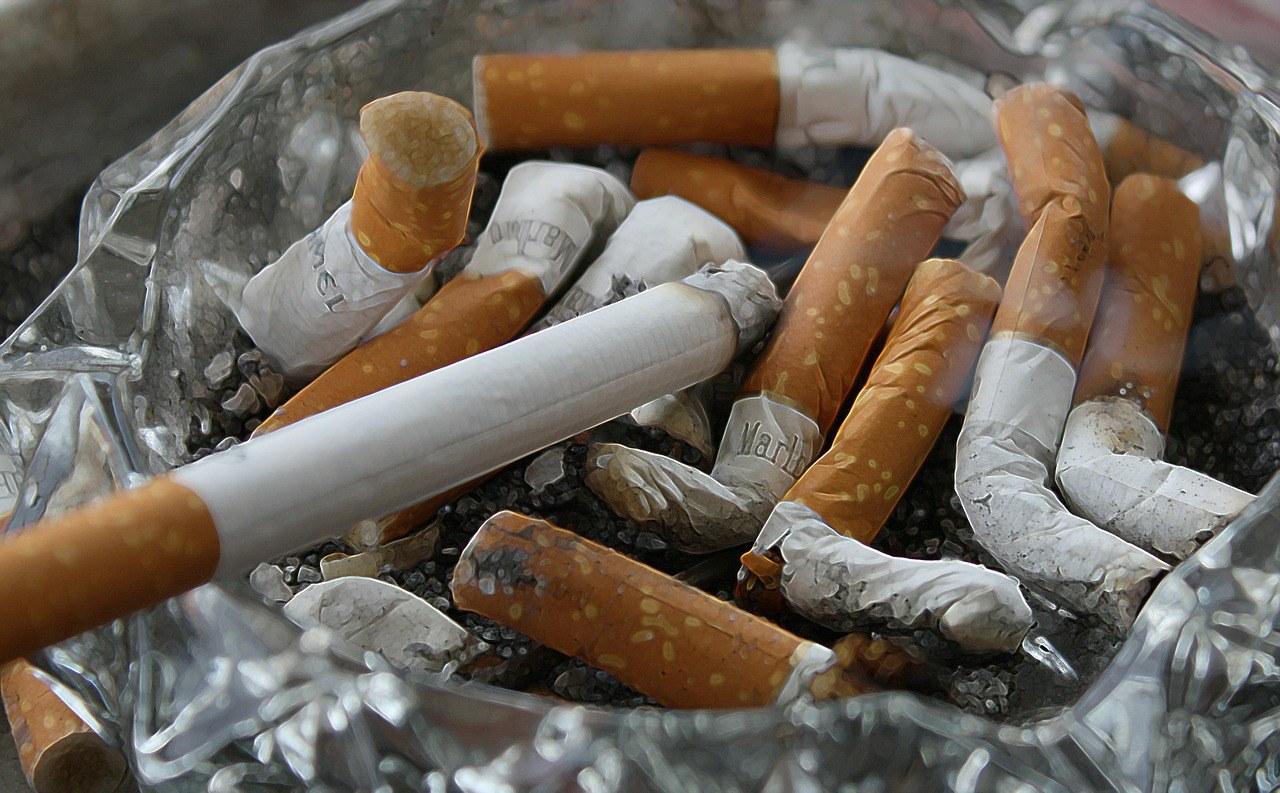

By Eileen Howard Boone
With a new school year underway, it’s an appropriate time to celebrate the country’s progress in protecting youth from smoking and tobacco use, while considering new concerns that could undermine this public health success story in the future.
The extraordinary decline in youth cigarette smoking, which the Centers for Disease Control and Prevention (CDC) reported fell to a record low of 10.8 percent in 2015 from 15.7 percent two years earlier, is due to the continued tobacco-control interventions at the federal, state and private-sector levels. And it will save millions of lives and billions of dollars in healthcare costs in the years to come.
However, there are troubling new signs that students continue to experiment with tobacco use and are engaging in new risk behaviors, such as the use of e-cigarettes, that deserve our continued attention and focus.
According to the CDC’s National Youth Risk Behavior Survey, 31 percent of high-school students reported using some form of tobacco. Worse still, 24 percent of high-schoolers said they used e-cigarettes, which are marketed with kid-friendly flavoring that increases their popularity with young people. This remains an area of concern for all of us in the public health community because most of these products contain nicotine -- which causes addiction, could harm brain development, and could lead to continued tobacco product use for a new generation of young people.
That’s why CVS Health extended our commitment to helping people lead tobacco-free lives with the introduction of Be The First: a five-year, $50 million initiative to help deliver a tobacco-free generation comprised of comprehensive education, tobacco control and healthy behavior programming in partnership with organizations on the front lines of this public health challenge. Since launching the campaign in March, Be The First has set into motion a series of evidenced-based strategies, partnerships and programs that are contributing to the nation’s tobacco control efforts, which include:
- working with the American Academy of Pediatrics to support training initiatives for clinicians around the country which will focus on screening for smoke exposure in the household, provide smoking cessation offerings for parents and explain the dangers of secondhand smoke and the importance of reducing tobacco use;
- introducing a three-year, $3.6 million initiative with the American Cancer Society to help accelerate and expand the number of college and university campuses throughout the United States that are 100 percent tobacco-free.
- working with the Campaign for Tobacco Free Kids' to increase the number of young people trained in youth advocacy around key tobacco issues so they can make an impact in their local communities;
All of us – in government and public health, as well as parents and students – should be proud of the progress we’ve made together in the nation’s fight against tobacco use. But the rise in usage of e-cigarettes and other tobacco products should encourage us to remain diligent.
Let’s use this new school year to recommit ourselves to this winnable effort. And by continuing to bring our collective focus and resources to the issue, we can sustain the progress being made where a tobacco-free generation seems possible, and not simply an aspiration.
Image credit: Pixabay
Eileen Howard Boone is Senior Vice President of Corporate Social Responsibility and Philanthropy for CVS Health, and President of the CVS Health Foundation.